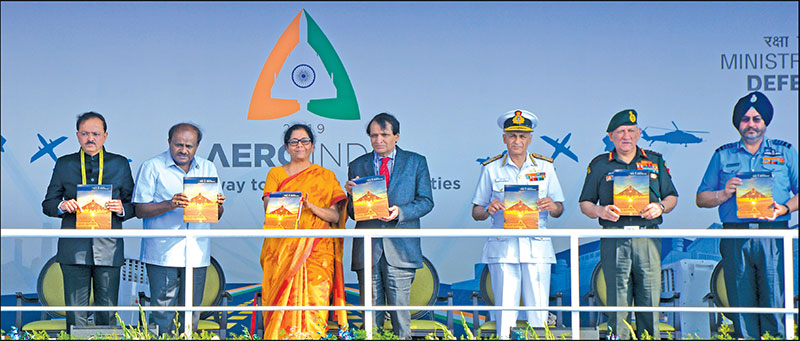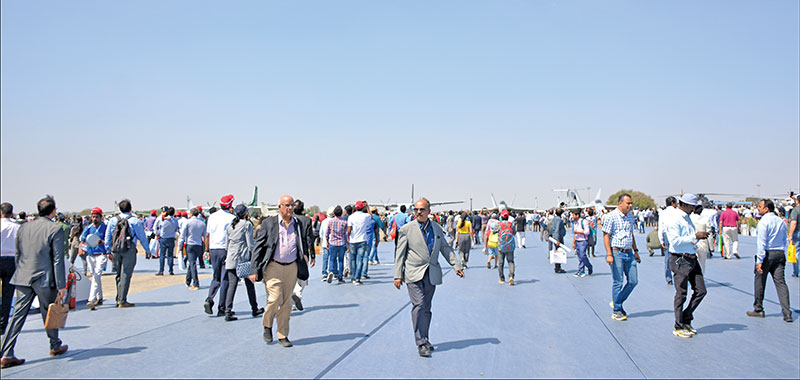Aero India 2019 fails to rise above its inherent infirmities
Ghazala Wahab
Bengaluru: Eventually he relented. But not before the agitated Indian Air Force officer had made his point.

“Sir, these arrangements are for your own security. If there is a mishap, it is people like you who will blame us,” he said in a voice bordering on angry frustration. Both his frustration and our plea were valid. Two days before Aero India 2019, confusion was writ large. His objection was to the gate numbers mentioned on the individual entry badges and the vehicle pass, both of which didn’t match. One allowed entry from Gate No 1, and another from Gate No 2b.
Are you suggesting, officer, that my car should go inside without me from this gate and I should walk down from another gate, despite having valid entry passes?
He nodded.
But eventually, both the car and I will be going inside. What is the logic of entering from separate gates days before the show when exhibitors are still setting up their stands?
If the reasonableness of the argument convinced him, he didn’t show it. He allowed the car in as a favour after a brief speech on the importance of following security guidelines. This was all very well, because by the time the show was ready for inauguration on February 20, even the modicum of security had ceased to exist.
The same car was waved in casually on the morning of February 20, when Union ministers, Nirmala Sitharaman, Suresh Prabhu, D.V. Sadananda Gowda and Subhash Bhamre along with Karnataka chief minister H.D. Kumaraswamy were expected to be at the show, in addition to several international delegations, some led by ministers.
Perhaps, they are lax because we have come in very early, we reasoned. The inauguration was scheduled at 9am and we entered at 7.15 am. However, security, or lack of it, was the subject of several conversations over the next few days.

“Isn’t it amazing that given the present times, the security arrangements are so poor,” an exhibitor from a British company marvelled referring to the terrorist attack in Kashmir which killed 40 personnel of the Central Reserve Police Force a week ago. Following this attack, a high alert was sounded in several Indian cities and airports.
Recounting her experience that morning, she said that all executives from her company came in a bus which was shooed-in without any checks. None of the individual badges were run through the handheld scanners. “After alighting from the bus, I simply walked to my hall with my handbag and the laptop without any X-ray screening,” she said in total disbelief.
An exhibitor from Russia had a similar story, though he recounted it more in amusement than complaint.
“Our bus driver was very smart,” he said jocularly. “When we reached the gate, there was a police vehicle ahead of us. Our driver told the security that we were with them. They just let us pass. At all the access points, from the main gate till the chalets, the driver kept pointing to the police vehicle. Nobody stopped us. Nobody checked us.”
In earlier editions of Aero India, the lack of security was often because of the equipment breakdown — sometimes the scan machines didn’t work or the handheld detectors collapsed under the weight of their responsibility — but this time, there was a total lack of interest. The personnel manning the equipment also didn’t insist on people walking through the access control gates. Twice, I was casually frisked by security ladies busy on their mobile phones!
This lack of interest permeated other areas too. Cleanliness for instance. The permanent residents of the vintage hangars, which are converted into exhibition halls, frequently made their presence felt to the temporary inhabitants by way of bird or cat droppings over the stands. It was common to see monkeys chase after cats on the iron beams that criss-crossed the hangars.
At first, the foreign exhibitors were amused, as they usually are at the sight of animals in urban, commercial spaces. But once the droppings started dotting the exhibits, there was a rush for the house-keeping staff — an extremely incongruent way to refer to the elderly ladies who walked around the halls with brooms and garbage collection bags trailing behind them on the carpet. These ladies were indeed in a class of their own. Every time they would empty the litter basket inside the booth into their cavernous bags, they would soundlessly extend their hand for a tip.
A brief mention here about the toilets. This year, the organisers dropped even the pretence of maintaining the toilets, which remained devoid of dustbins, soaps, paper towels and toilet paper throughout the show. As far as cleanliness was concerned, the ladies assigned with this job couldn’t enter the Show on the first day as they were held up at the entrance. Some confusion about their badges, a young volunteer in a ‘may I help you’ t-shirt helpfully informed the women who complained about the messiness of the toilets. The ‘confusion about the badges’ probably persisted for the next few days because this section of the house-keeping remained invisible.
A Show of First
Twin tragedies marked the show, which started with a ball of fire that killed Wg Cdr Sahil Gandhi and ended with a raging blaze that consumed over 400 cars. Wg Cdr Sahil Gandhi died a day before the show when his Hawk AJT collided with another Hawk during the rehearsal of the Surya Kiran aerobatic team.
And nobody knows who started the fire — a carelessly thrown cigarette, or simply indifference towards security.
Yet, ironically, this was the first time when all theoretical boxes were checked by the organisers. An emergency room with two ambulances was created right in the middle of the exhibition. And a posse of young volunteers were deployed to assist the exhibitors/ visitors. What’s more, a tax-payer’s pavilion was created as a one-stop shop for all Indian visitors to the Show, in case they had some tax-related queries which couldn’t wait until they exited the Show!
Not to forget the pavilion dedicated to defence shipyards at an air show. “What can we do, if the ministry of defence orders us we have to come,” said a representative from one of the shipyards explaining his presence. If the numbers had to be beefed up, perhaps the commercial airlines could have been ordered to participate too.
Free With Figures
Confusion reigned at the inauguration ceremony too, which metamorphosed into a web of selective facts, exaggerations, and contradictory statistics. The confusion began even as the ministerial entourage led by defence minister Nirmala Sitharaman and accompanied by minister for civil aviation Suresh Prabhu was climbing up the stage. The emcee announced that the chief minister of Karnataka H.D. Kumaraswamy would join the dignitaries shortly. But Kumaraswamy was already there, bringing up the rear. Once everyone was settled on the stage, including defence secretary, the three service chiefs and secretary DRDO, the emcee invited secretary defence production to give the welcome address.
Glances were exchanged. Defence minister Sitharaman urged her junior minister Subhash Bhamre to give the welcome address instead. Thereafter aviation minister Suresh Prabhu was invited to deliver the keynote address. Prabhu did a fast work of his address. The civil aviation sector has been growing at the rate of 20 per cent every month for the last four years he said, a measure of which was the addition of 100 airports. His government has also made air travel affordable to such an extent that even villagers can now travel by air. The irony that despite the growth in the aviation sector, various Indian airlines have been facing grave sustainability crisis, thereby raising questions about this lopsided growth, escaped his attention.
Yet another keynote address was delivered by the chief minister who took this opportunity to underline the importance of Bengaluru and Karnataka as aerospace and defence hub in India and the measures that his government had taken to facilitate this, including the creation of aerospace special economic zone.
The chief minister had barely finished, when his predecessor and now Union minister of statistics and programme implementation D.V. Sadananda Gowda arrived on the stage. When the emcee invited the defence minister to give her chief guest’s address, she declined, inviting Gowda to speak instead. Probably unprepared, Gowda expressed happiness for being at Aero India and urged everyone, from exhibitors to visitors, to enjoy the show.
Finally, the defence minister took the podium, and Aero India got off to a flying start, primarily on the wings of the statistics that she began to churn out. The first off-the-block was the participation figures at the show — 600 Indian and 200 foreign companies. It’s another matter that the Aero India website listed total exhibitors as 403. The other baffling figure was of defence exports, which according to her had seen an increase of 400 per cent in the last four years; and the recipients of this included countries like Russia and Israel among others. Not only this, she claimed that India has manufactured 4,000 aircraft so far. Her list included platforms like the C-295 that have not even been contracted for as yet. At least, the OEMs waiting to see the end of these protracted negotiations would have been pleased with this.
Earlier, while welcoming the presence of her Cabinet colleague Suresh Prabhu, she declared that for the first time Aero India had joined hands with civil aviation. “This makes this edition of the show truly unique,” she said. In 2017, her predecessor Manohar Parrikar had jointly inaugurated the 11th edition of Aero India with the then civil aviation minister Ashok Gajapathi Raju, even as the junior minister for civil aviation Jayant Sinha had cheered them.
Carried away by the liberty his minister took with figures, secretary defence production in his vote of thanks declared 75 per cent increase in the number of exhibitors over the previous edition of Aero India!
In an election year, perhaps, such indulgence with statistics is par for course.

